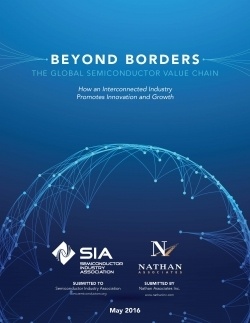New Report Highlights Benefits, Impact of Global Semiconductor Value Chain
Friday, May 06, 2016, 8:31pm
by Semiconductor Industry Association
INTERCONNECTED ECOSYSTEM SPURS INNOVATION AND GROWTH, BENEFITS PARTICIPATING COUNTRIES
WASHINGTON—May 6, 2016—The Semiconductor Industry Association (SIA), representing U.S. leadership in semiconductor manufacturing, design, and research, today released a new report highlighting the evolution, complexity, and pivotal importance of the global semiconductor value chain. The report, drafted by Nathan Associates and titled, “Beyond Borders: How an Interconnected Industry Promotes Innovation and Growth,” emphasizes the global value chain’s tremendous benefits to technological advancement, semiconductor companies, affiliated industries, participating countries, and the global economy. The report also warns of the risks of attempting to reproduce the entire value chain within a single country.
“Much like the intricate circuitry of chips themselves, the global semiconductor value chain is a complex, interdependent network that is highly efficient, productive, and constantly evolving,” said John Neuffer, president and CEO, Semiconductor Industry Association. “This interlocking ecosystem drives growth and innovation and strengthens participating countries by increasing employment and export opportunities.”
The “Beyond Borders” report examines how the semiconductor value chain weaves together researchers, designers, manufacturers, assemblers, and suppliers from all over the world to create the building blocks of modern electronics. The system is driven in part by the extreme complexity and competitive nature of the industry itself. Nonstop, competition-driven demand for more and better capabilities, features, reliability, miniaturization, and speed at reduced cost requires a heavy investment in research and development, design, and efficient, low-cost manufacturing, testing, assembling and packaging, and distribution.
These same pressures also affect a vast array of supporting activities, such as the production of semiconductor manufacturing equipment, development of design software and other semiconductor intellectual property, and provision of raw materials. The pressures have compelled semiconductor companies to develop business models that look beyond national borders to achieve efficiencies to compete in the marketplace. Moving forward, this trend is likely to continue and intensify as the demand for innovation becomes even greater, according to the report.
“The semiconductor industry is relentlessly focused on the future, on exploring and advancing new technological frontiers such as brain-inspired computing, the Internet of Things, energy-efficient sensing, automated devices, robotics, and artificial intelligence,” Neuffer said. “A globally interdependent system that links together the strengths and capabilities of each participant will help the semiconductor industry unlock new technologies that will shape the future of the digital economy.”
About SIA
The Semiconductor Industry Association (SIA) is the voice of the U.S. semiconductor industry, one of America’s top export industries and a key driver of America’s economic strength, national security, and global competitiveness. Semiconductors – microchips that control all modern electronics – enable the systems and products we use to work, communicate, travel, entertain, harness energy, treat illness, and make new scientific discoveries. The semiconductor industry directly employs nearly a quarter of a million people in the U.S. In 2015, U.S. semiconductor company sales totaled $166 billion, and semiconductors make the global trillion dollar electronics industry possible. SIA seeks to strengthen U.S. leadership of semiconductor manufacturing, design, and research by working with Congress, the Administration and other key industry stakeholders to encourage policies and regulations that fuel innovation, propel business and drive international competition. Learn more at www.semiconductors.org.
